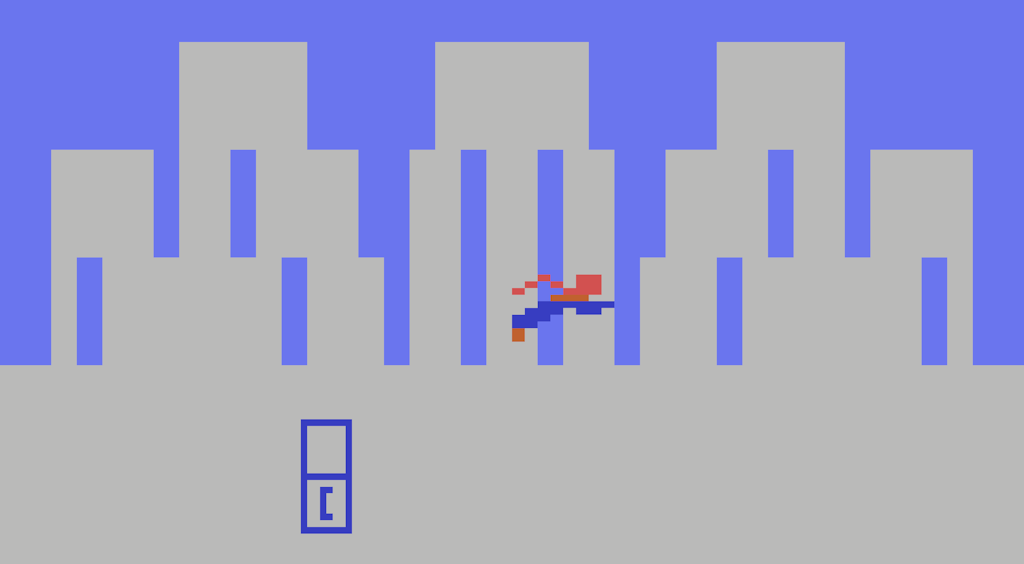
Console Gaming History Adventure: 1979
It’s a bird! It’s a plane! No, it’s Luna somehow zipping through this project wayy faster than she expected to, continuing on from 1978 to 1979!
Several new consoles came out this year, but even with that, we have slightly fewer new games to play with than last year – 43 new cartridges with 52 new games to try out.
While it didn’t actually lead to the release of any games until next year, I can’t leave unmentioned the drama that was taking place at Atari in 1979 because it was just so important to gaming history going forward! While Generation 2 consoles had introduced the idea of games being made separate from the consoles themselves, those games were still being made by the same company as the console, and there was no concept of third-party game development. This was the year that changed, when Atari’s four best game developers at the time, unhappy with the way the company was treating them, decided to quit and form their own separate company, called Activision, that would create games for other people’s consoles, mainly the Atari VCS. Atari felt nobody had the legal right to make games for their console without their permission, and that led to a big fight about it in court! 🫣 The conclusion of that battle would ultimately have really horrible consequences for the whole industry – more on that in the articles for later years!
New Consoles
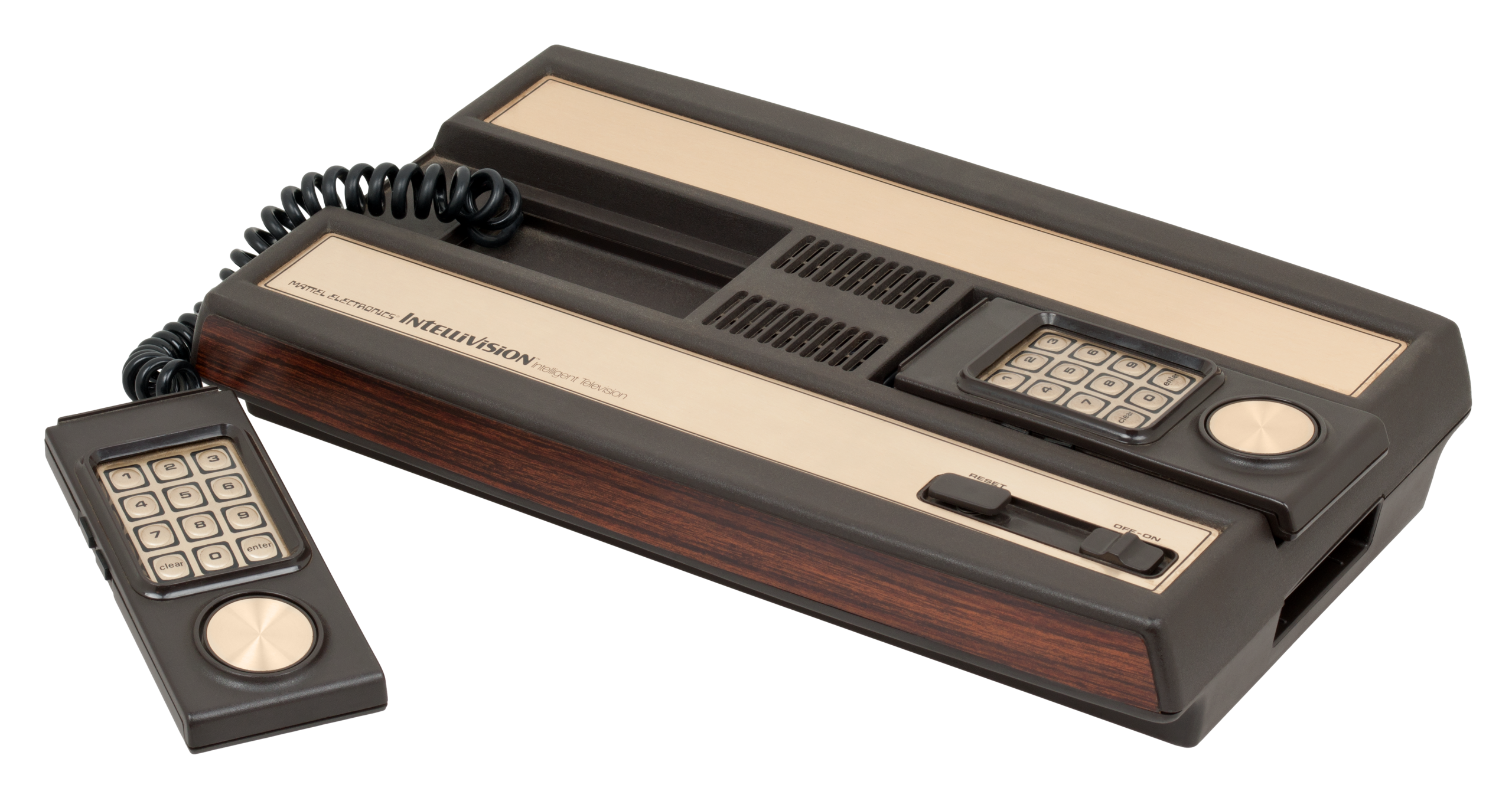 This was the year the Mattel Intellivision was first available, but only as a test release in a few cities in the United States, so you would have had a tough time getting ahold of one until next year! The Intellivision was a lot more powerful than the dominant Atari VCS. Like the Bally Professional Arcade, the Intellivision was able to make much better use of roughly the same screen resolution than the VCS. It seems to me like the Bally Professional Arcade offered better detail but the colors were a lot better on the Intellivision games. Mattel’s ad campaigns showed prospective buyers just how much more detailed, colorful, and realistic equivalent games were able to be for the Intellivision when compared with the VCS, but the Intellivision was also more expensive, with an introductory price of 275USD (1,183.08USD today)! The VCS also had a much better game selection.
This was the year the Mattel Intellivision was first available, but only as a test release in a few cities in the United States, so you would have had a tough time getting ahold of one until next year! The Intellivision was a lot more powerful than the dominant Atari VCS. Like the Bally Professional Arcade, the Intellivision was able to make much better use of roughly the same screen resolution than the VCS. It seems to me like the Bally Professional Arcade offered better detail but the colors were a lot better on the Intellivision games. Mattel’s ad campaigns showed prospective buyers just how much more detailed, colorful, and realistic equivalent games were able to be for the Intellivision when compared with the VCS, but the Intellivision was also more expensive, with an introductory price of 275USD (1,183.08USD today)! The VCS also had a much better game selection.
The Intellivision had an exceptionally sophisticated controller for the time, with 4 “action buttons” on the sides (though the top two had to have the same function in games) and a 16-way, pressable digital “disc” for movement that was arguably the game industry’s very first “control pad” instead of the clumsy digital sticks controllers had been using up until now. The phone-like numeric keypad in the center was also used for game functions, and most games came with a little card that could be slipped overtop of the numpad that let you easily see what the numbers did in that specific game.
This controller, combined with the console’s superior graphics, enabled games to have a lot more depth and complexity to them than what was possible with the VCS. I think this was often too much of a good thing, and many Intellivision games can be very complicated to learn to play. Get ready to hit the manual and really study up when it comes to most games to be able to play at all. Get ready for really complicated functions being set up with the numpad when it would make overwhelmingly more sense to just let you navigate a menu with a joystick and an action button to do the same thing. I found myself groaning almost as loudly when it was time for an Intellivision game as I did with the AFP M-1000/MP-1000. 😣
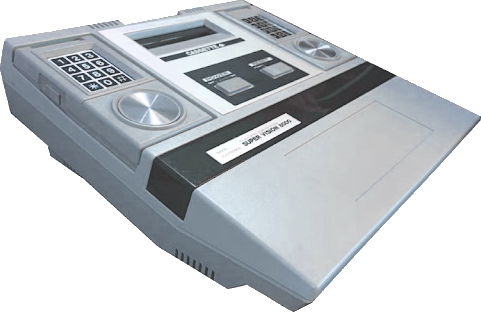 (NO ACCESS) Also released this year was a very obscure Japanese gaming console called the Bandai Super Vision (not to be confused with the “Watara Supervision” portable gaming console from 1992). The console only over had 7 games released for it, all from 1979, and it was never sold outside of Japan, so it sounds like it wasn’t too successful, and it’s now mostly known today as an exceptionally rare collector’s item. I was curious why it looks so much like the Intellivision but there isn’t much information I can find on this thing. I guess the introductory price for it was 56,800JPY (equivalent to about 90,403JPY today), which is overwhelmingly cheaper than most of the American consoles we’ve talked about so far (just over 570 in 2024 USD). After the console’s quick failure, Mattel and Bandai made a deal that had Bandai selling Intellivision clones to the Japanese audience instead.
(NO ACCESS) Also released this year was a very obscure Japanese gaming console called the Bandai Super Vision (not to be confused with the “Watara Supervision” portable gaming console from 1992). The console only over had 7 games released for it, all from 1979, and it was never sold outside of Japan, so it sounds like it wasn’t too successful, and it’s now mostly known today as an exceptionally rare collector’s item. I was curious why it looks so much like the Intellivision but there isn’t much information I can find on this thing. I guess the introductory price for it was 56,800JPY (equivalent to about 90,403JPY today), which is overwhelmingly cheaper than most of the American consoles we’ve talked about so far (just over 570 in 2024 USD). After the console’s quick failure, Mattel and Bandai made a deal that had Bandai selling Intellivision clones to the Japanese audience instead.
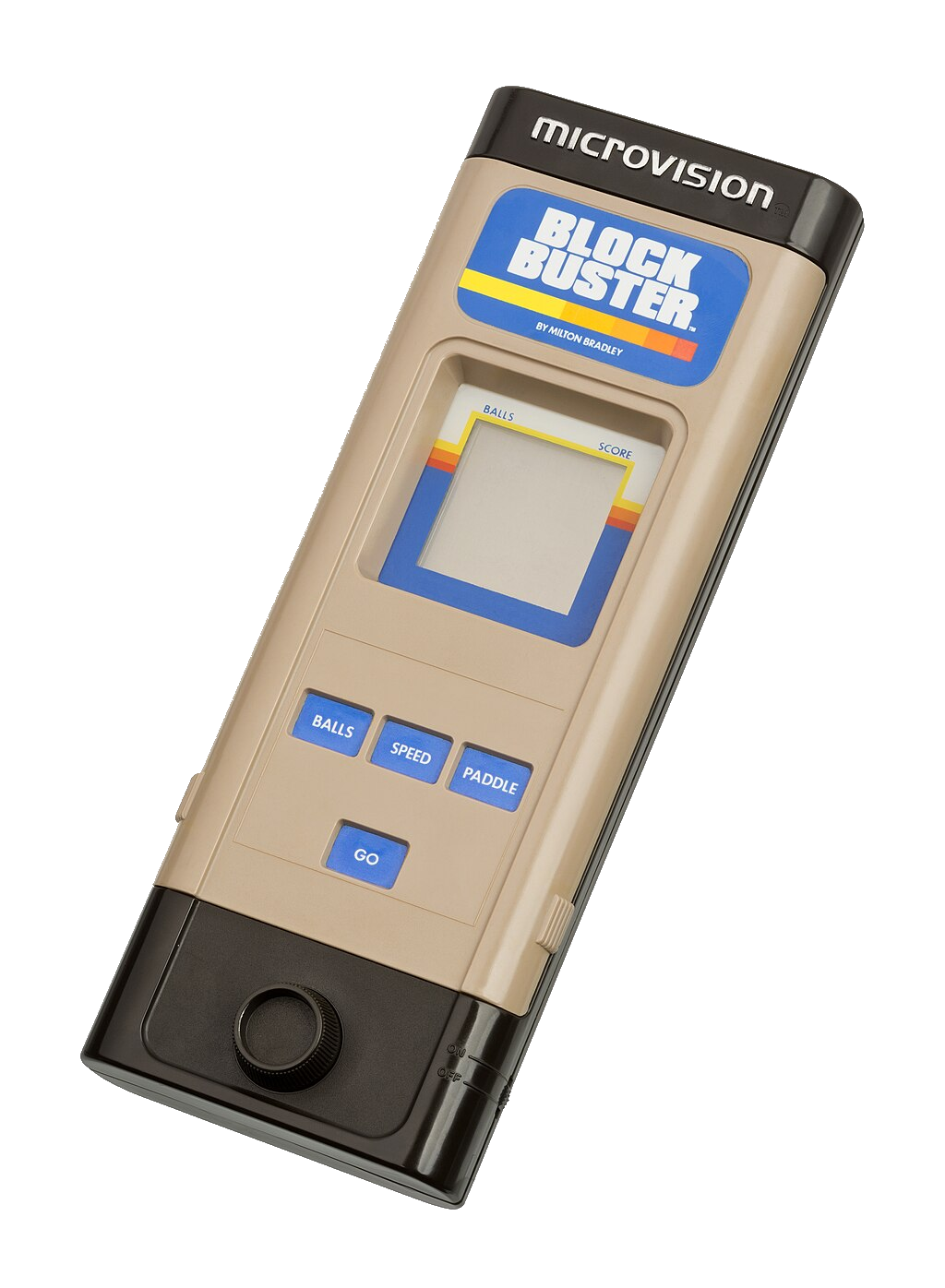 (NO ACCESS) Also coming out this year was something really special, the Milton Bradley Microvision. It’s special because it’s the very first portable gaming console – or at least, the very first portable gaming console that had separate games for it. Stuff like this wouldn’t become normal for a while yet because the tech was just too primitive at the time, but Milton Bradley decided to make a go of it with a whopping 16×16 screen resolution, 16 bytes of RAM, and a 49.99USD (215.06USD today) introductory price. The device has serious problems with reliability that affect its longevity no matter how good you are at taking care of it, so it’s incredibly rare to find a Microvision in usable shape today and soon they will all be gone from the world. 😢
(NO ACCESS) Also coming out this year was something really special, the Milton Bradley Microvision. It’s special because it’s the very first portable gaming console – or at least, the very first portable gaming console that had separate games for it. Stuff like this wouldn’t become normal for a while yet because the tech was just too primitive at the time, but Milton Bradley decided to make a go of it with a whopping 16×16 screen resolution, 16 bytes of RAM, and a 49.99USD (215.06USD today) introductory price. The device has serious problems with reliability that affect its longevity no matter how good you are at taking care of it, so it’s incredibly rare to find a Microvision in usable shape today and soon they will all be gone from the world. 😢
Returning Consoles
There were no new games for the Channel F this year. I guess the cumulative market fail by this point meant the console had been sold off to a company called Zircon International. Zircon released an updated version of the console this year, called the “Channel F System II”, with detachable controllers, improvements to the case design, and audio that could now come out through the TV instead of directly from the console, but these changes didn’t involve any actual technical improvements to the console’s system specs, and so they weren’t enough to actually let it compete with the Atari VCS. It just played the same set of games as before. While 5 more Channel F cartridges would trickle out over the next two years – so it wasn’t quite dead yet – its glory days were well behind it.
The Bally Professional Arcade wasn’t doing so hot either! ☹️ At this point, Bally actually gave up on it and was looking to sell the division it was part of to another company. It wasn’t until 1981 that the console was “rereleased” by a new company and I haven’t been able to find out if it was even possible to buy the console or its games in the interim. The only game the Internet claims has a 1979 release date (Clowns + Brickyard) has a 1981 copyright on the box and manual with the new company’s name, so I don’t think it was actually available until then. There are no games for this thing listed with a 1980 release date at all.
This is also the final year with new official titles for the AFP M-1000/MP-1000 console line before it was put to pasture. I did actually find a single decent game for it this year, but this is still not a console I’m going to miss! 😒
The Atari VCS, on the other hand, was doing great, and by this time had become the clear king of the market. The Odyssey² also had plenty of new games come out this year… though I really didn’t like any of them. 🫤
Noteworthy Games
There was a lot of garbage to sift through, and without the Bally Professional Arcade to fall back on for great games, that limited my selection a lot. But I was still able to find some good ones! One is even for the AFP M-1000/MP-1000, oh yes!
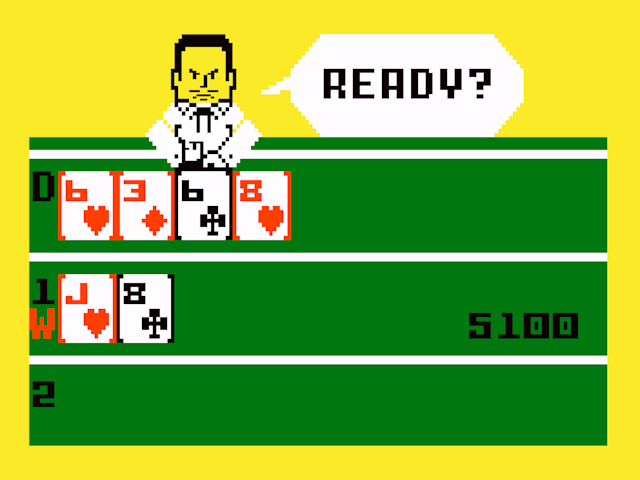 The first game I want to spotlight here is Las Vegas Blackjack and Poker for the Intellivision, which became more widely available in 1980 but was available along with the console in some select cities in 1979. I don’t normally like playing cards, and out of the included card games, I only know how to play Blackjack, but this title isn’t terrible, and I thought it was worth including here for a few reasons: For one, it’s an Intellivision game simple enough to play that I can recommend it (though you absolutely need the slideover card for the controller to make selections properly)! For another, this dealer and his cartoonish facial expressions when he wins or loses seems to be a sort of unofficial mascot for the Intellivision console on a few fan sites I’ve come across, so I feel like getting acquainted with this guy is probably important for understanding early gaming culture. He’s certainly amusing and made up of pretty detailed and sophisticated graphics for the time!
The first game I want to spotlight here is Las Vegas Blackjack and Poker for the Intellivision, which became more widely available in 1980 but was available along with the console in some select cities in 1979. I don’t normally like playing cards, and out of the included card games, I only know how to play Blackjack, but this title isn’t terrible, and I thought it was worth including here for a few reasons: For one, it’s an Intellivision game simple enough to play that I can recommend it (though you absolutely need the slideover card for the controller to make selections properly)! For another, this dealer and his cartoonish facial expressions when he wins or loses seems to be a sort of unofficial mascot for the Intellivision console on a few fan sites I’ve come across, so I feel like getting acquainted with this guy is probably important for understanding early gaming culture. He’s certainly amusing and made up of pretty detailed and sophisticated graphics for the time!
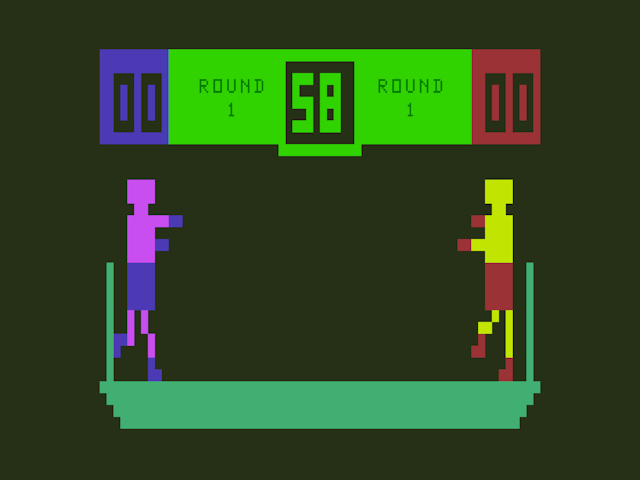 What’s this? Luna is recommending an AFP M-1000/MP-1000 game? Oh yes! Though it’s not great, it’s the one game I’ve found for the system that is both easy to figure out how to play and at least kinda entertaining for a few minutes. The simply named, simply played Boxing seems to be about timing your punches with your opponent to beat him. You can play against another player (at least I think that’s what’s going on here – it’s really hard to tell with this console’s confusing games!) or you can play against one of several computer personalities with cute nicknames. It’s not very challenging and it gets boring very quickly, so I wouldn’t say it was worth it back in the day, but it’s not completely devoid of entertainment value and I thought it would be nice to spotlight at least one game for this platform before it’s gone for good after this year!
What’s this? Luna is recommending an AFP M-1000/MP-1000 game? Oh yes! Though it’s not great, it’s the one game I’ve found for the system that is both easy to figure out how to play and at least kinda entertaining for a few minutes. The simply named, simply played Boxing seems to be about timing your punches with your opponent to beat him. You can play against another player (at least I think that’s what’s going on here – it’s really hard to tell with this console’s confusing games!) or you can play against one of several computer personalities with cute nicknames. It’s not very challenging and it gets boring very quickly, so I wouldn’t say it was worth it back in the day, but it’s not completely devoid of entertainment value and I thought it would be nice to spotlight at least one game for this platform before it’s gone for good after this year!
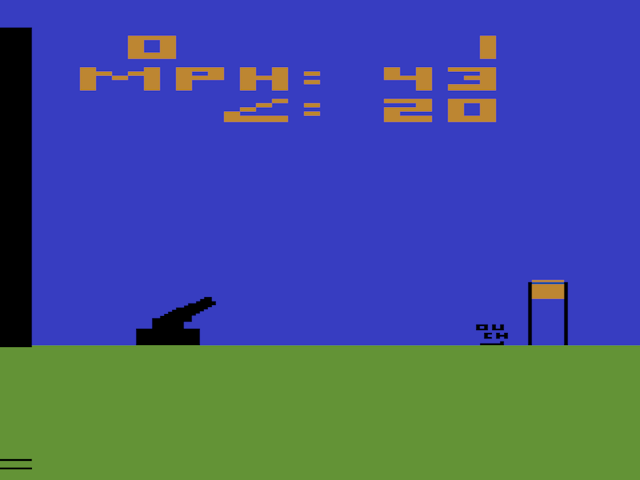 I really liked Human Cannonball for the Atari VCS. The goal is to launch a man out of his cannon and into a tower of water without missing. Any one of the variables – the angle of the cannon, the speed of the cannon, or the position of the cannon / water tower – may be your responsibility to set correctly, or they may be chosen by the computer, depending on which game variant you select to play with. While I’m not really into the mental tedium of entering numbers like this, I can’t help but be charmed by the dark humor of this game’s presentation, which seems so unusual for the time, maybe because you only barely have enough pixels to make it possible for people to tell what something is, and so that leaves little room for some artistic flair. But this game pulls it off – I find it particularly charming how they had to squeeze “ouch” into two lines with the size of the sprite it appears over! 😆
I really liked Human Cannonball for the Atari VCS. The goal is to launch a man out of his cannon and into a tower of water without missing. Any one of the variables – the angle of the cannon, the speed of the cannon, or the position of the cannon / water tower – may be your responsibility to set correctly, or they may be chosen by the computer, depending on which game variant you select to play with. While I’m not really into the mental tedium of entering numbers like this, I can’t help but be charmed by the dark humor of this game’s presentation, which seems so unusual for the time, maybe because you only barely have enough pixels to make it possible for people to tell what something is, and so that leaves little room for some artistic flair. But this game pulls it off – I find it particularly charming how they had to squeeze “ouch” into two lines with the size of the sprite it appears over! 😆
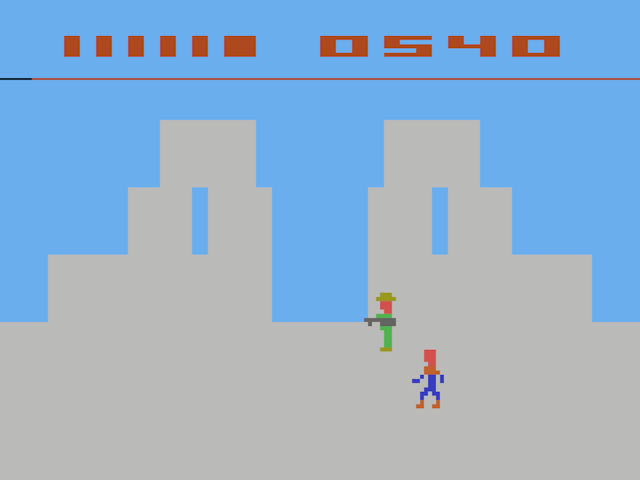 In my opinion though, the crown jewel of 1979 was Superman for the Atari VCS. Superman was a really anachronistic release for the time in many ways. For one thing, it was the first console game to be based on non-gaming intellectual property, which also effectively made it into the first console game to feature a named, memorable player character (I guess it was made to be a tie-in for the 1978 Superman movie, which I haven’t seen). For another, it was the first console game with a non-linear world to explore, where you could move your player character from screen to screen, searching around to complete objectives. I would argue that it was also the first console game that really had something for you to ‘complete’ at all. The console games back then almost always just unquestioningly aped the way arcade games worked, where you just sat down for a session and tried to get a higher score. Superman was arguably no different really, since it had a count-up timer that let you play over and over trying to finish the objectives as fast as possible. But that timer wasn’t really a concern for your first play-through, where you are just trying to explore Metropolis to find escaped criminals and pieces of the bridge they blew up in order to “beat” the game, which gives this old title a starkly modern feel to anyone trying to play it today.
In my opinion though, the crown jewel of 1979 was Superman for the Atari VCS. Superman was a really anachronistic release for the time in many ways. For one thing, it was the first console game to be based on non-gaming intellectual property, which also effectively made it into the first console game to feature a named, memorable player character (I guess it was made to be a tie-in for the 1978 Superman movie, which I haven’t seen). For another, it was the first console game with a non-linear world to explore, where you could move your player character from screen to screen, searching around to complete objectives. I would argue that it was also the first console game that really had something for you to ‘complete’ at all. The console games back then almost always just unquestioningly aped the way arcade games worked, where you just sat down for a session and tried to get a higher score. Superman was arguably no different really, since it had a count-up timer that let you play over and over trying to finish the objectives as fast as possible. But that timer wasn’t really a concern for your first play-through, where you are just trying to explore Metropolis to find escaped criminals and pieces of the bridge they blew up in order to “beat” the game, which gives this old title a starkly modern feel to anyone trying to play it today.
The game is still really short, which it had to be because the concept of saving your game didn’t exist yet. The conventions around how to chain together and navigate multiple screens of an open world also didn’t exist yet, which makes getting around Metropolis really confusing. But for all its archaic flaws, I think it’s incredibly interesting to see the birth of what would become the modern video game as gamers know it today. I really think you should try it!
Meanwhile, in Arcade Land…
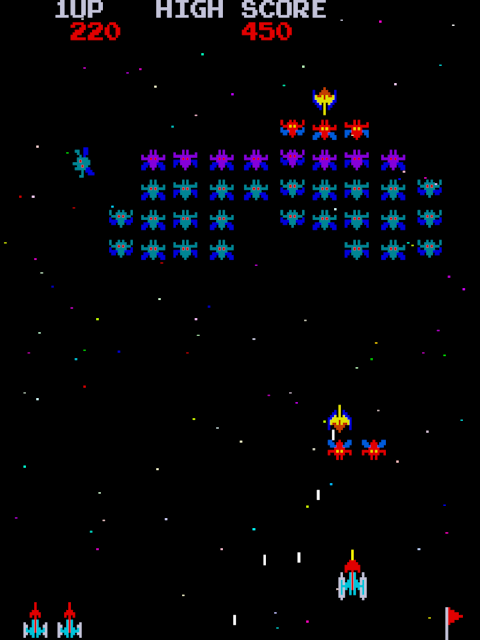 I don’t see any real improvement in the graphic quality of 1979’s console games compared with 1978, but with the arcades, it’s another story! What I read about 1978’s “Space Invaders” was right, and 1979 really seems to be the year when arcade cabinet hardware got the huge boost it needed to finally start producing some really beautiful and fun games! While most Space Invader clones were just utterly shameless knock-offs from creatively lazy, sleezy, greedy companies, others tried to innovate on the concept in wonderful ways, with Galaxian being the most famous and well-known example! This was the birth of the “shooter” genre of video games – one of my favorites – that would slowly work its way into consoles too!
I don’t see any real improvement in the graphic quality of 1979’s console games compared with 1978, but with the arcades, it’s another story! What I read about 1978’s “Space Invaders” was right, and 1979 really seems to be the year when arcade cabinet hardware got the huge boost it needed to finally start producing some really beautiful and fun games! While most Space Invader clones were just utterly shameless knock-offs from creatively lazy, sleezy, greedy companies, others tried to innovate on the concept in wonderful ways, with Galaxian being the most famous and well-known example! This was the birth of the “shooter” genre of video games – one of my favorites – that would slowly work its way into consoles too!
Not that complex shooters with huge numbers of smoothly animated sprites were all the new hardware made possible. While console games remained frustratingly crude and primitive, I feel like this was the year that arcade games finally reached the minimum graphics threshold where the graphics no longer interfere with the fun of the game. You don’t need to use your imagination anymore to tell what you are looking at, and along with better graphics, the games seem a lot more clever and creative too! As for color, there were still a few games only available in black and white, relying on color overlays and physical backdrops for anything more, but they were a clear minority in what I saw.
Conclusion
This is happening much faster than I thought now that I’m used to it. With the exception of “Superman” there is nothing to really beat yet, and for the majority of games, it doesn’t take too long for me to read through the manual and then spend a few minutes to experience all its content with a few quick rounds of play. At this rate it shouldn’t be too long before I have an article out for 1980, but even before the more involved, beatable games appear in the mid 1980s, I think I’m gonna be slowed down a lot by the way there are more and more games to get through each year. We’ll see how it goes! The unknown is what makes the experience an adventure!